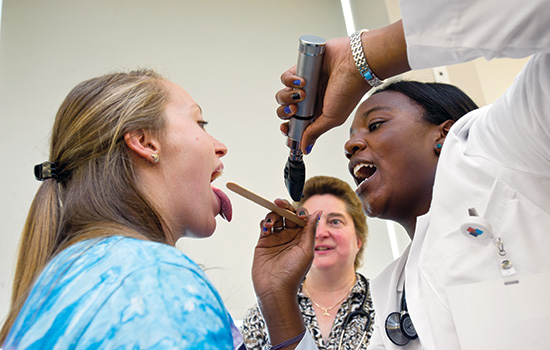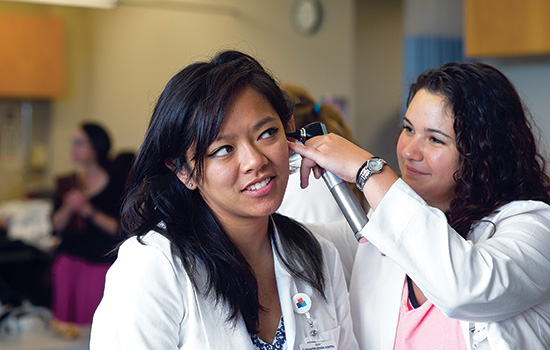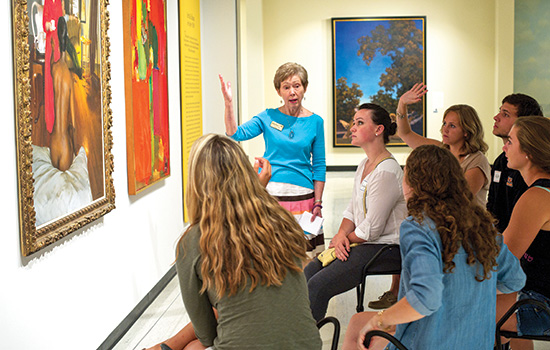Medical program matures to fill national need
A. Sue Weisler
Third-year physician assistant students wondered why their orientation to the professional phase of their education included a stop at the Memorial Art Gallery. Changing the context from medicine to art forced the students to focus on the process of collecting facts without jumping to conclusions and to listen to each other’s reasoning. After a year of medical training, the PA cohort will retake the class with a new perspective. The two-hour program was taught by Dr. Stephanie Brown Clark, director/associate professor, department of medical humanities and bioethics at the University of Rochester Medical Center School of Medicine and Dentistry.
Rachel Triassi thought she would go to medical school until a chance meeting with a physician assistant unexpectedly broadened her career options.
“I had never heard of PAs before,” said Triassi, now a fourth-year student in the BS/MS physician assistant program at RIT. “That sparked my interest.”
Triassi and her cohort in the physician assistant class of 2016 are training to be nationally certified, state-licensed medical professionals who practice medicine on health-care teams with physicians and other providers. The U.S. Bureau of Labor Statistics ranks physician assistants as the 13th fastest-growing occupation in the country, with faster-than-average increases expected to reach 38 percent by 2022. The median annual wage as of 2012 was $90,930.
The numbers reflect a critical time in health care. The demand for medical professionals is increasing as baby boomers age, medical doctors retire and people gain coverage through the Affordable Health Care Act.
“I don’t think there’s any question that PAs are definitely part of the solution to the current health-care problems,” said Heidi Miller, director of the physician assistant program since its inception at RIT in 1993. “The tremendous employability of our graduates has been just phenomenal. There are close to 500 alumni, and I’m not aware of anyone not working as a PA who wants to be.”
The class of 2016 is the first to go through the five-year BS/MS degree and represents a new phase of the physician assistant program at RIT.
Triassi and her peers are also the first PA students to remain on campus for a fourth year. Students in the former BS program spent their senior year gaining clinical experience in five-week blocks in 10 different practice areas and health-care settings. The graduate students will begin their clinical internships in June 2015, after an additional year of classroom education.
“We graduated the last group of BS students this past May,” Miller said. “As a result of this transition, we don’t have students on clinical rotations this year for the first time ever in the 20-year history of the program. This is a planned and predicted transition and one-year only.”
The PA degree, formerly housed in the College of Science, is one of the foundational programs of RIT’s College of Health Sciences and Technology.
RIT’s ninth college opened in 2011 as the academic prong of the Institute of Health Sciences and Technology, part of the alliance and collaborative partnership between RIT and Rochester General Health System, now known as the Rochester Regional Health System.
The class of 2016 arrived at a pivotal time in the PA program’s history, starting as first-year students in the new college and entering the third year—the professional phase and medical education—during the first fall semester at RIT. Miller had timed the third year of the BS/MS curriculum to coincide with the university’s switch to the semester system during the 2013–2014 academic year.
The BS/MS degree gives fourth-year students more time to delve deeper into their medical education through new classes like hospital practice, clinical integration and clinical epidemiology. Courses on research methods will prepare students to complete a graduate project on topics pertaining to patient education, best practices or community resourcing, for instance, during their year of clinical experience.
Evolution of PAs
Miller and Nancy Valentage, associate director, have a long history with the physician assistant program. Miller was a practicing PA at Rochester General Hospital in the late 1980s when RIT’s then-Department of Allied Health Sciences approached the hospital about starting a physician assistant program. She joined RIT to run the program and was soon followed by Valentage, a practicing PA at the former Genesee Hospital. The PA educators have watched their program and their profession mature in the last two decades.
“The terminal degree for physician assistants used to be a certificate, then it moved to a bachelor’s degree, now by 2020, all physician assistant programs must be at the master’s level,” Valentage said.
The PA profession has a reputation for flexibility. After passing their national boards, practitioners can diagnose and treat patients as part of a medical team in any state in the country. The profession demands a commitment to lifelong learning and offers variety—PAs can move between practice areas throughout their career.
Alumna Erin Stafford ’08 has worked as a hospital internal medicine physician assistant at the Mayo Clinic Hospital in Phoenix for the past six years and enjoys a variety of responsibilities.
“I have the opportunity to sit down and have meaningful conversations with patients and their families about serious medical conditions,” Stafford said. “I am also able to treat acute cases that require emergent intervention. You get to see it all in hospital medicine—you see patients in the ER, ICU, post-anesthesia care unit and on the medical/surgical floors.”
Highly competitive
RIT’s PA program launched in 1993 with the professional phase. Students who met the prerequisites began as juniors. Seventeen students earned their BS degrees in 1995. RIT’s young program gained accreditation and grew at a controlled pace.
Twenty-seven PA students in the class of 2014 graduated this past May with the program’s final BS degrees. This year’s incoming class of 2019 began with a record 36 students.
The program’s emphasis on academics and leadership yields top-notch candidates from the several hundred applications received every year.
Winning a seat in the program is highly competitive. The program depends upon available training sites in the region for students to fulfill their required clinical experience. Increased competition for clinical sites between other PA and medical programs in the region limits RIT’s program size, Valentage said.
Miller and Valentage take pride in pairing their students with clinical sites that will enhance their training.
They conduct quality assurance to verify the level of acuity, caseload and supervision, and run criminal background checks on potential preceptors.
“We are asking people in the medical community to take our students and train them, spending time with them for five weeks,” Miller said. “That challenge has increased in the last 21 years. It’s become more competitive. Those are things that keep us up at night.”
Many alumni also serve as preceptors. Stafford is a physician assistant educator at the Mayo Clinic who works with students from a variety of programs. Stafford shares with them wisdom she learned from Valentage before beginning her own clinical experience.
Valentage’s advice is a mantra for student and professor.
“I say the exact same thing to every class, year after year when preparing them for the start of clinical rotations,” Valentage said. “Be the first on your team to arrive in the morning, the last person on your team to leave at night, read constantly, and embrace all rotations even if it may not be your favorite. You never know when a caveat of clinical knowledge you learned on a rotation you thought you wouldn’t like will pertain to a future patient of yours.”
Years later, Valentage’s words still resonate with Stafford. “That always stuck with me,” she said. “Even when I was on a rotation that wasn’t my favorite, I gave it my all. I think that attitude prepared me well for clinical practice.”
Working together
A focus on team unifies physician assistant students and practitioners.
“The core philosophy of this whole program has always been about team because you don’t practice medicine in a vacuum,” Miller said. “PAs are known to be exceptionally good at the concept of team medicine, keeping the patient at the center of care.”
RIT’s program has a reputation for rigor and intensity of course material. The pressure is high: PA students on rotation are expected to have the same foundation of clinical knowledge as first-year residents, Triassi noted.
“They teach that we are a team,” Triassi said. “We work together. We’re not competing against each other for grades or to be the best. We’re helping each other get through. The person who is struggling the most—that’s where the whole class is going to be because the whole class helps push them along. They may be struggling now, but you may be struggling next week.”
Triassi and the class of 2016 will begin their clinical rotations in summer 2015. They will not be present when the physician assistant program moves, in the fall, into its new quarters in the Clinical Health Sciences Center. Its former home, the Center for Bioscience Education and Technology, will remain headquarters for the dean’s office and the non-clinical programs in the College of Health Sciences and Technology.
RIT broke ground this past spring on the new home for the college’s clinical programs and a primary care clinic that Rochester General Hospital will operate.
The PA suite in the 45,000-square-foot facility expansion at the north end of Louise M. Slaughter Hall will nearly double the program’s current space and provide simulation rooms and storage for its growing collection of patient-care models.
Medical programs across the country are turning to simulation manikins to prepare students to work with real patients in a safe environment.
“Medical simulation is part of the future of the program,” Valentage said. “Our students can train on the static models and learn the basic skill sets of suturing, IVs, medication administration. We can program a heart arrhythmia in a computerized manikin. This is great for team training before they see patients during their clinical year of training.”
Attention PA alumni
No plans are in the works at the moment for a stand-alone master’s degree in physician assistant studies at RIT, according to Heidi Miller, director of the physician assistant program. Alumni seeking graduate education are encouraged to consider the online master’s degree in health systems administration offered by the College of Health Sciences and Technology, Miller said.
 Physician assistant professor Nancy Valentage observes Jesslyn Doody’s examination techniques on fellow fourth-year student Margaret Kolb.
A. Sue Weisler
Physician assistant professor Nancy Valentage observes Jesslyn Doody’s examination techniques on fellow fourth-year student Margaret Kolb.
A. Sue Weisler
 Fourth-year physician assistant student Alexandra Williams practices her physical examination skills with her practice partner Vivian Nguyen.
A. Sue Weisler
Fourth-year physician assistant student Alexandra Williams practices her physical examination skills with her practice partner Vivian Nguyen.
A. Sue Weisler










